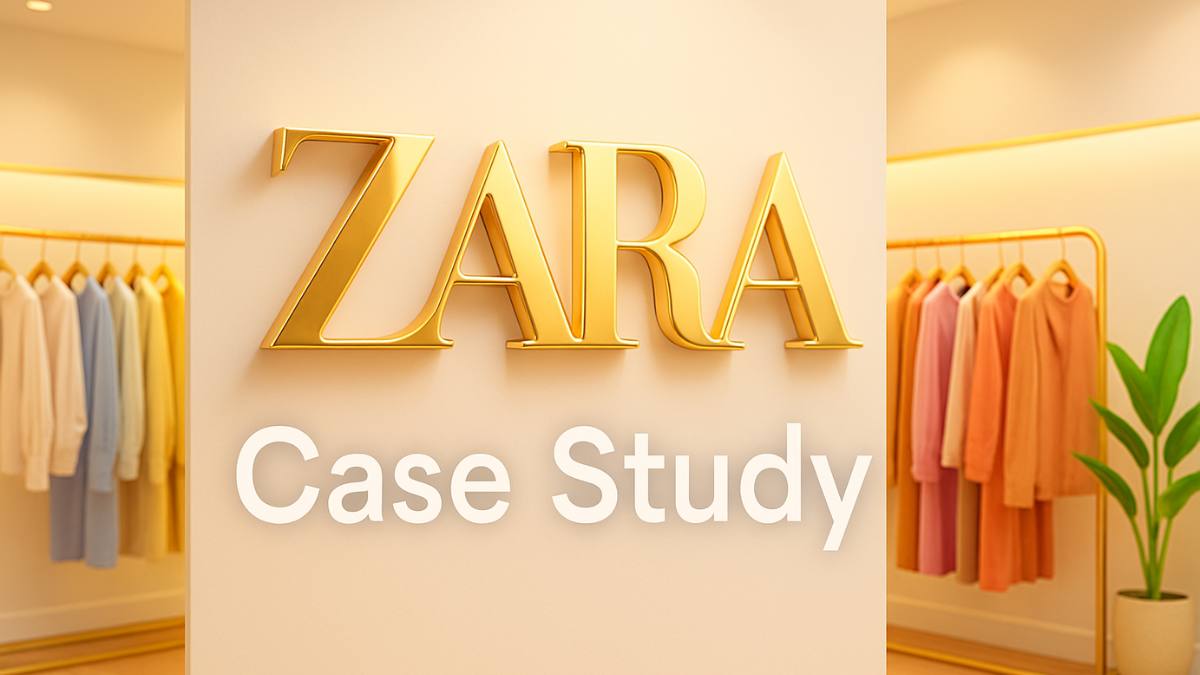In the world of fast fashion, one brand continues to stand in a league of its own, Zara. Whether you’re a marketer, startup founder, or just someone curious about how modern businesses scale rapidly, the Zara case study is more than just a tale of good clothes and sleek stores. It’s a masterclass in speed, customer obsession, and strategic restraint.
Zara didn’t become a $16+ billion brand (under parent company Inditex) by screaming the loudest. It did it by listening carefully, to shoppers, store managers, data, and the market’s heartbeat.
So, what can today’s entrepreneurs, brand builders, and marketers learn from this quiet powerhouse? Let’s dive deep.
Table of Contents
Zara’s Business Model: Fast, Focused, Flexible
Zara’s engine runs on three F’s: Fast, Focused, and Flexible.
Most fashion companies operate on a 6–9 month product cycle. Zara? It moves from design to shelf in as little as 2–3 weeks. That kind of speed isn’t magic, it’s the result of vertical integration. Zara controls much of its supply chain, from design and prototyping to manufacturing and logistics.
Here’s something worth noting: Zara deliberately limits inventory. Instead of overstocking, it creates smaller batches that are constantly refreshed. That way, the store always feels “new”, and items fly off shelves because customers know they may not return.
To meet global demand at such a rapid pace, Zara produces over 450 million items per year (Source), an astonishing volume that still feels curated thanks to its limited-inventory strategy. This scale, paired with precision, is what makes its fast fashion machine so effective.
Scarcity isn’t a flaw. It’s a strategy. And it’s deeply psychological. When people feel they might miss out, they act fast.
Also Read: Myntra Case Study
What Sets Zara Apart from Other Fashion Brands?
Let’s be honest. Fashion isn’t short of players, H&M, Uniqlo, Shein, Primark. But what makes Zara… well, Zara?
Also Read: Uniqlo Case Study
Speed Over Seasons
While traditional brands work around rigid fashion seasons, Zara is in a constant feedback loop. It doesn’t wait for “Spring/Summer 2026.” If a new silhouette starts trending on social or on the streets of Milan, Zara can prototype and roll it out globally within weeks.
In-House Control
About half of Zara’s products are manufactured close to its Spain headquarters. That means tighter quality control, faster turnarounds, and fewer dependencies.
Demand-Led Design
Designers aren’t sitting in an ivory tower sketching abstract concepts. They’re working off real feedback, from stores, customers, and even competitors. Zara stores double as real-time validation labs.
Also Read: Starbucks Case Study
How Zara Collects & Leverages Customer Data
Zara doesn’t talk at customers, it listens. And this might be its most underrated superpower.
Store staff are trained to observe shopper behavior, note requests, and relay this to headquarters. You want a red version of that top? If enough people ask, it’ll likely hit shelves within a month.
But the data flywheel doesn’t stop there.
- POS systems track what’s selling and where.
- Inventory logs identify slow movers.
- Store-level insights help tweak the assortment per region or even per neighborhood.
It’s not Big Brother. It’s Big Feedback, and it powers the brand’s agility.
Also Read: Digital Marketing Training in Panchkula
Digital Marketing & Minimal Advertising: Zara’s Unique Approach
One of the wildest facts in this Zara case study? Zara spends surprisingly little on advertising. No mega celebrity campaigns. No massive influencer drops. No TikTok ads spamming your feed.
Instead, Zara lets its stores do the talking. Think prime locations, minimalistic windows, and limited-stock items. That physical presence is part retail, part billboard.
Zara’s confidence in its product and experience means it doesn’t need to chase virality. It earns attention.
And honestly? That approach is a great reminder of what we teach in our Advanced Digital Marketing Course at Young Urban Project, sometimes, the best marketing isn’t louder. It’s smarter and more aligned with how your audience naturally behaves.

Tech & Innovation: The Backbone of Zara’s Agility
If Zara were a startup, it’d be called a fashion-tech company.
- Zara was an early adopter of RFID technology. This lets it track each garment in real time, from factory to shelf to fitting room (Source).
- Its ERP systems link design, production, and logistics under one roof, creating insane speed and clarity.
- Machine learning helps in forecasting demand based on weather, sales patterns, and even social media sentiment.
Also Read: Advanced Performance Marketing Training
Global Expansion with Localized Execution
Zara is a global brand, but it acts locally.
The brand’s expansion strategy isn’t to copy-paste stores everywhere. Instead, it tailors each location based on demand, climate, and cultural trends. For instance, Zara’s stores in Tokyo might lean minimalist, while those in Dubai might favor vibrant color palettes.
This local responsiveness is amplified by Zara’s global logistics network. Every store sends real-time sales data back to HQ. If a product is hot in Seoul but tanking in Paris, adjustments happen fast, not next season.
Also Read: Amazon Case Study
Sustainability: Zara’s Ongoing Challenge
It’d be incomplete to do a Zara case study without acknowledging its biggest criticism, fast fashion’s environmental cost.
Zara isn’t immune to this. The sheer speed and volume of clothing contribute to waste and overconsumption.
However, the brand is making visible efforts:
- The “Join Life” collection uses sustainable materials like organic cotton and Tencel.
- Its garment recycling program runs in multiple countries.
- Zara has set goals to eliminate hazardous chemicals and achieve carbon neutrality, as per public reports from Inditex.
Still, sustainability purists remain skeptical. Progress? Yes. Perfection? Not yet.
Also Read: What is Green Marketing?
Key Takeaways for Entrepreneurs, Marketers, and Creators
So, what can we learn from Zara, beyond just fashion?
Here are some solid takeaways:
- Speed > Perfection: You don’t need to launch the final version. Launch, learn, and iterate.
- Data is Creative Fuel: Let customer behavior shape your strategy, not gut feelings alone.
- Own the Chain: Whether it’s manufacturing, content, or community, the more control you have, the faster you can move.
These aren’t just Zara’s principles. They’re playbooks for any modern marketer or creator looking to scale.
Also Read: Flipkart Case Study
Conclusion: Can Zara’s Model Be Replicated?
Let’s keep it real, most startups can’t replicate Zara 1:1. You’re probably not going to build a global logistics empire overnight or produce 24,000 new designs a year.
But the mindset? That’s gold.
Move fast. Stay close to your customer. Build feedback loops. Focus on what matters, and cut the fluff.
Zara isn’t just a fashion company. It’s a lesson in business agility, customer obsession, and strategic silence.
If you apply even 10% of what they do in your business or your marketing, you’ll be way ahead of the curve.
Also Read: McDonald’s Case Study
FAQ: Zara Case Study
Q1. What is Zara’s market share in the fast fashion industry?
As part of Inditex, Zara leads the global fast fashion market. According to Statista, Inditex held a global revenue of over €38 billion in 2024, with Zara accounting for a large chunk.
Q2. What are Zara’s core product categories?
Zara covers women’s, men’s, and kidswear, along with accessories, shoes, and increasingly, home decor.
Q3. Who are Zara’s major competitors?
Main competitors include H&M, Uniqlo, Shein, and Primark. Zara differentiates by blending high-speed production with curated exclusivity.
Q4. How does Zara market its products with minimal advertising?
Zara relies on prime retail locations, scarcity, and product quality, rather than heavy ad spend, to create buzz and repeat customers.
Q5. How does Zara use technology in its operations?
Tech like RFID, advanced ERP systems, and AI-driven trend forecasting helps Zara manage inventory, speed up production, and meet demand with precision.
Q6. What can marketers and entrepreneurs learn from Zara’s strategy?
Speed over polish. Feedback over opinion. Own your execution. And remember, sometimes silence speaks louder than a campaign.

